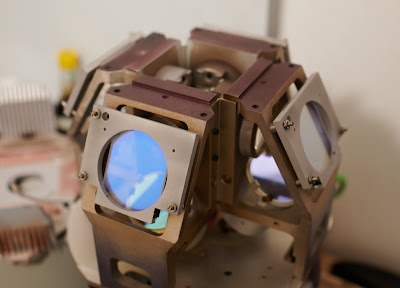 |
| The yellow lights make it look more legitimate |
I have always wanted to expose a wafer. I'd written off making my own transistors long ago (nothing that fits in a house is good for feature sizes small enough for interesting logic, and I'm not a good enough analog engineer to design interesting analog), but there are many useful optical and mechanical parts that can be made lithographically.
The usual route to home lithography is a microscope and a DLP, but the resultant ~2mm field sizes are not sufficient for mechanical parts and stitching a 20mm field out of 2mm subfields is very taxing on your motion system. Contact aligners are simple and perform well, but getting submicron resolution for interesting optical parts out of a contact aligner is challenging (the masks also get quite expensive).
The natural solution is to start with a stepper lens (which is basically a giant microscope objective with very bad color correction). There are a few variants - 1:10 lenses with a 10x10mm field, 1:5 lenses with a 14x14mm field, and 1:4 lenses, which weigh several hundred kg and have a 20x20mm field. Stepper lenses also come in several colors: g-line (436nm), i-line (365nm), and DUV (~250nm).
I wound up with a 1:5 g-line lens; the 1:5 lenses strike a good balance between performance and unwieldiness. I also had a set of stages pulled from a DNA sequencer good for a couple microns of resolution. The rough plan was to stack a fine stage on top of these and use a direct-viewing technique to perform alignment. However, the project quickly went south when I realized building an exposure tool entailed buying the parts out of an...exposure tool. Conveniently, a circa 1985 GCA DSW 6100C showed up for more or less scrap value near me, so one rigging operation later I was the proud owner of a genuine submicron stepper.
The DSW family of steppers are true classics; GCA Mann practically invented the commercial stepper in the late 70's. The GCA steppers remained more or less unchanged until the company's demise; everything from the g-line DSW 4800 to the AutoStep 200 shared a stage design, alignment system, and mechanical construction (unfortunately, they also all shared a terrible 70's-grade electronics package!). A number of GCA tools still survive in university fabs, mostly converted to manual operation. Briefly, the design consists of:
- A cast-iron base with a cast-iron 'bridge' holding the optical column.
- A stacked stage consisting of two coarse mechanical bearing stages driven by servomotors, two fine flexure stages constructed as a single unit driven by voice coil actuators, and a open-loop, limited-travel rotation stage driven by DC motors.
- Feedback provided by an HP 5500-series interferometer that meters the displacement between two mirrors mounted to the optical column and two flats mounted to the fine stage.
- A reticle alignment stage consisting of a small flexure actuator and fine-pitch screws for adjustment.
- A focusing system using a photoelectric height sensor and a linkage mechanism that adjusts the entire optical column height (!) with a travel range of around 1mm.
- An alignment system using two fixed microscopes to align the origin and rotation of the wafer.
- A high-pressure mercury arc lamp with a homogenizer and filter (MAXIMUS) to illuminate the reticle with Kohler illumination of the appropriate wavelength.
As luck would have it, practically every screw in the Maximus was loose, and the bulb was snapped in half. The rebuild took a couple hours, and was greatly improved by removing the head from the stepper - dealing with loose lenses is much easier when you are not six feet off the ground (if by some chance you are reading this and also servicing a GCA stepper, removing the Maximus is easy - just pull the four socket head screws at the base of the condenser, un-route the shutter cables and lamp cables, and the unit lifts right off).
I haven't had a chance to check performance yet, as the bulb needs replacement. The Maximus uses Ushio USH-350DP bulbs. Of critical note: the USH-350DP is a two-screw-terminal designed for aligners. The Maximus uses a screw-on "bullet" on one end to convert it to a plug-in type; if you are changing bulbs, don't throw out the plug!
Additional GCA resources
- Here is a collection of various official GCA manuals scraped off the internet, mostly from university sites. The information in the manuals is helpful for understanding how the system works. If you are intent on actually using the stock GCA controller, the manuals are pretty much mandatory, since the PDP-based software is not very user friendly.
- Here are various pieces of documentation from third parties (once again, mostly academic fabs). Additionally, there are several good DSW guides:





